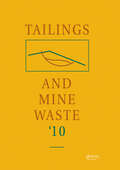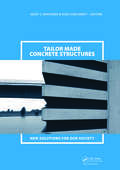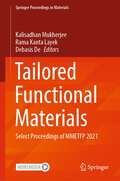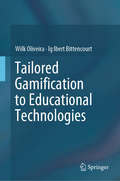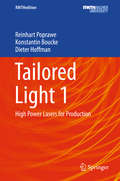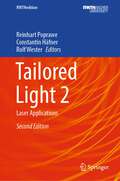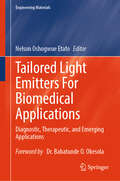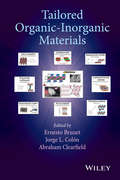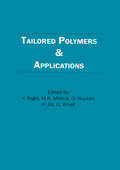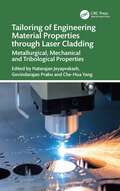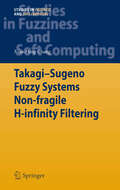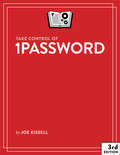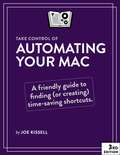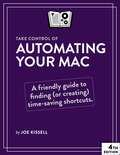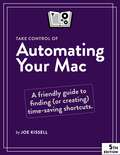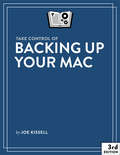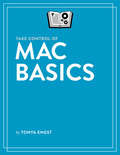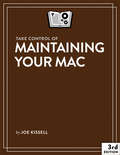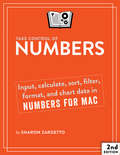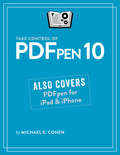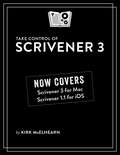- Table View
- List View
Tailings and Mine Waste 2010
by Chippenham WiltshireTailings and Mine Waste 10 contains the contributions from the 14th annual Tailings and Mine Waste Conference, held by Colorado State University of Fort Collins, Colorado in conjunction with the University of Alberta and the University of British Columbia. The purpose of this series of conferences is to provide a forum for discussion and establish
Tailor Made Concrete Structures: New Solutions for our Society (Abstracts Book 314 pages + CD-ROM full papers 1196 pages)
by Joost C. Walraven Dick StoelhorstIn recent years knowledge of concrete and concrete structures has increased, as has its applications. New types of concrete challenged scientists and engineers, and ecological constraints encouraged the implementation of life cycle design of concrete structures, moving the focus more and more to maintenance and uprating of structures. And since bui
Tailored Functional Materials: Select Proceedings of MMETFP 2021 (Springer Proceedings in Materials #15)
by Debasis De Kalisadhan Mukherjee Rama Kanta LayekThis book presents the select proceedings of the International Symposium entitled “Materials of the Millennium: Emerging Trends and Future Prospects” (MMETFP 2021). It discusses the synthesis, tailoring, and characterization of different materials for functional applications in various sectors which include but not limited to energy, environment, biomedical/ health care, construction, transportation etc. Topics covered in this book are synthesis and characterization of polymers, ceramics, composites, biomaterials, carbon-based nanostructures as well as materials for green environment, structural materials, modeling and simulation of materials. The book also covers the topic of emerging trends in nanostructured materials, thin films, and devices. The book is useful for students, researchers, and professionals working in the various areas of materials science and engineering.
Tailored Gamification to Educational Technologies
by Ig Ibert Bittencourt Wilk OliveiraThis book introduces and explores the field of tailored gamified educational technologies. Providing a theoretical overview of the domain, including a number of related psychological and educational theories along with a complete state-of-the-art analysis on this topic, it presents an approach and architecture to tailor these systems to students’ gamer type and age.
Tailored Light 1: High Power Lasers For Production (Rwthedition Ser.)
by Reinhart Poprawe Konstantin Boucke Dieter HoffmanThe Laser world consists basically of two areas, which are necessary and in many cases also sufficient for effective innovation: The right laser for the right application. For the individual application that means the determination of optimized process parameters in terms of laser power, peak power/ intensity, focus geometry and dimension, pulse length, pulse repetition rate and wavelength to name only the six most important ones. Once these parameters are identified, the corresponding Laser has to be selected on the basis of commercial availability. Obviously there is no such thing than "One Laser for all". The situation is rather comparable with electrical power, were depending on the demand of the application in terms of voltage, current and time corresponding power supplies need to be tailored, however, with the difference that in the case of the Laser the variety of parameters is even higher, thus the technology is more complex but on the other hand much more flexible in terms optimizing the source to the application. As a consequence it is suggested to generate two volumes on Lasers and Applications named "Tailored Light".
Tailored Light 2: Laser Applications (RWTHedition)
by Reinhart Poprawe Constantin Häfner Rolf WesterThis book covers the application technology of lasers, focusing more on the vast range of processes than on individual applications, in order to motivate and enable future innovations. The physical basics are presented in the first half of the book. The following examination of application categories and their processes is documented by experts from their practical points of view but always refers back to the underlying physical principles. In this way, readers are free to choose their own individual level of depth in understanding this globally relevant field of innovation.This new edition of Tailored Light 2: Laser Applications birings the book up to date with the latest applications of laster technology.
Tailored Light Emitters For Biomedical Applications: Diagnostic, Therapeutic, and Emerging Applications (Engineering Materials)
by Nelson Oshogwue EtafoThis book provides a comprehensive guide to the development, testing, and medical applications of photoluminescent materials. It covers key material classes—such as quantum dots, organic fluorophores, and lanthanide-doped nanoparticles—and explores how their light emission properties can be tailored for medical use. Readers will find in-depth discussions on biocompatibility strategies, targeted drug delivery with light-triggered release mechanisms, in vivo imaging for real-time therapeutic monitoring, and advanced diagnostic techniques like biosensors and fluorescence assays. The book also delves into photoluminescence-based therapies, including antibacterial treatments, photoimmunotherapy, and cancer phototherapy, offering researchers and practitioners the tools to develop safe and effective next-generation medical technologies.
Tailored Organic-Inorganic Materials
by Jorge L. Colón Abraham Clearfield Ernesto BrunetThis book explores the limitless ability to design new materials by layering clay materials within organic compounds. Assembly, properties, characterization, and current and potential applications are offered to inspire the development of novel materials. Coincides with the government's Materials Genome Initiative, to inspire the development of green, sustainable, robust materials that lead to efficient use of limited resources Contains a thorough introductory and chemical foundation before delving into techniques, characterization, and properties of these materials Applications in biocatalysis, drug delivery, and energy storage and recovery are discussed Presents a case for an often overlooked hybrid material: organic-clay materials
Tailored Polymers and Applications
by Y. Yagci M. K. Mishra O. Nuyken K. Ito G. WnekThis book contains a selection of papers presented at APME '99 ( Third International Symposium on Advanced Polymers via Macromolecular Engineering --- Colonial Williamsburg, VA, USA, July/August 1999). The book focuses on the synthesis of targeted polymers with specific properties using macromolecular architecture. Various controlled polymerization
Tailoring of Engineering Material Properties through Laser Cladding: Metallurgical, Mechanical and Tribological Properties
by Che-Hua Yang Natarajan Jeyaprakash Govindarajan PrabuIn this comprehensive guide to laser cladding of engineering materials, expert contributors provide a detailed yet easy‑to‑follow explanation of the process, its use for surface modification and the benefits and applications of this technique in different environments and for different purposes.The optimization of an engineering material’s properties and behavior is vital for economic, safety and quality assurance reasons when these materials are applied in various industrial settings. This book therefore explains how laser cladding can be used to tailor and control a material’s surface layer properties, such as its elastic and plastic deformation and permanent detachment in the form of debris during the contact of mating parts. Through individual chapter contributions from experts in various elements related to laser cladding, this book guides readers through the evaluation of different structures in laser‑cladded engineering materials. The book addresses three key questions: What is the influence of micro- and nano-level structures on mechanical properties? How does laser cladding improve a material’s wear resistance at the micron and nano level and determine the material’s suitability for particular applications? What challenges are related to the laser cladding of different engineering materials? In addressing these questions, the book enables readers to determine the metallurgical, mechanical, tribological and corrosion behavior of any type of engineering material. Readers will also be able to make informed decisions based on their knowledge of the properties and industrial applications of different laser‑cladded materials.This book is essential for all manufacturing industry personnel who work with materials in various industrial settings and need to control their surface properties and enhance their behavior at the micron and nano levels. Students who are building experience prior to entering industry will also benefit from the detailed descriptions, step‑by‑step approach and focus on practical application.
Takagi-Sugeno Fuzzy Systems Non-fragile H-infinity Filtering
by Xiao-Heng ChangTakagi-Sugeno Fuzzy Systems Non-fragile H-infinity Filtering investigates the problem of non-fragile H-infinity filter design for Takagi-Sugeno (T-S) fuzzy systems. Given a T-S fuzzy system, the objective of this book is to design an H-infinity filter with the gain variations such that the filtering error system guarantees a prescribed H-infinity performance level. Furthermore, it demonstrates that the solution of non-fragile H-infinity filter design problem can be obtained by solving a set of linear matrix inequalities (LMIs). The intended audiences are graduate students and researchers both from the fields of engineering and mathematics. Dr. Xiao-Heng Chang is an Associate Professor at the College of Engineering, Bohai University, Jinzhou, Liaoning, China.
Take Control of 1Password (3.0)
by Joe KissellEasily create and enter secure passwords on all your devices! Wrangling your web passwords can be easy and secure, thanks to 1Password, the popular password manager from AgileBits. In this book, Joe Kissell brings years of real-world 1Password experience into play to explain not only how to create, edit, and enter web login data easily, but also how to autofill contact and credit card info when shopping online, audit your passwords and generate better ones, handle two-factor authentication (2FA), and sync and share passwords in various ways--including a hosted 1Password account (individual, family, or team), iCloud or Dropbox.While reading Take Control of 1Password on my iPad I was furiously highlighting passages and following along with 1Password open on my Mac. [The book] showed me how some of my passwords were weak or duplicates. I immediately changed those passwords to unique and secure ones.--Elisa Pacelli, in her MyMac book review (2nd Edition).The book focuses on 1Password 6 for the Mac, but it also provides details and directions for the iOS, Windows, and Android versions of 1Password. It briefly covers 1Password X, a chrome extension that brings 1Password to Chrome OS and Linux. Topics include: Meet 1Password: Set your master password, explore the various 1Password components, and decide on your ideal usage strategy. Master logins: In 1Password, a typical login contains a set of credentials used to sign in to a website. Find out how to create logins, sort them, search them, tag them, and more. You'll also find help with editing logins--for example, changing a password or adding further details. Understand password security: Get guidance on what makes for a good password, and read Joe's important Password Dos and Don'ts. A special topic covers how to perform a security audit in order to improve poor passwords quickly. Go beyond web logins: A primary point of 1Password is to speed up web logins, but 1Password can also store and autofill contact information (for more than one identity, even), along with credit card information. You'll also find advice on storing passwords for password-protected files and encrypted disk images, plus ideas for keeping track of confidential files, software licenses, scans of important cards or documents, and more.Sync your passwords: Discover which 1Password syncing solution is right for you: a hosted 1Password account, Dropbox, iCloud, a manually synced folder, or even device-to-device Wi-Fi sync.Share your passwords: Learn to store passwords in shared vaults within a family or team hosted account.You'll also discover the answers to key questions, including: What are my options for licensing 1Password? What are the differences between vaults in 1Password accounts and standalone vaults? Should I keep using my web browser's autofill feature? What about iCloud Keychain? Should I use that too? What can I do quickly to get better password security? How can I find and update weak passwords I created long ago?What should I do about security questions, like the name of my pet? How can 1Password provide a time-based one-time password (TOTP)? How do I use 1Password logins from utilities like LaunchBar?
Take Control of Apple Home Automation
by Josh CentersThanks to Apple's HomeKit platform, you can easily configure smart home devices (such as light bulbs, outlets, thermostats, sensors, cameras, and door locks) from a variety of manufacturers to behave exactly as you need them to; integrate them with a hub such as a HomePod, Apple TV, or iPad; and control them with an iOS device, a Mac, an Apple Watch, Siri commands, or automated programming. This book gives you all the information you need to get started.
Take Control of Apple Home Automation
by Josh CentersThanks to Apple's HomeKit platform, you can easily configure smart home devices (such as light bulbs, outlets, thermostats, sensors, cameras, and door locks) from a variety of manufacturers to behave exactly as you need them to; integrate them with a hub such as a HomePod, Apple TV, or iPad; and control them with an iOS/iPadOS device, a Mac, an Apple Watch, Siri commands, or automated programming. This book gives you all the information you need to get started.
Take Control of Apple Home Automation (1.0)
by Josh CentersThis book explains how to use Apple’s HomeKit home automation platform to control smart devices in your home, such as lights, outlets, thermostats, and more.
Take Control of Automating Your Mac
by Joe KissellEver wondered if automation could make your life easier? In "Take Control of Automating Your Mac, Third Edition," Mac expert Joe Kissell shows you how to save time and aggravation by using numerous built-in macOS tools, as well as helpful third-party apps, to automate routine tasks and procedures.
Take Control of Automating Your Mac
by Joe KissellEver wondered if automation could make your life easier? In "Take Control of Automating Your Mac, Fourth Edition," Mac expert Joe Kissell shows you how to save time and aggravation by using numerous built-in macOS tools, as well as helpful third-party apps, to automate routine tasks and procedures.
Take Control of Automating Your Mac
by Joe KissellEver wondered if automation could make your life easier? In "Take Control of Automating Your Mac, Fifth Edition," Mac expert Joe Kissell shows you how to save time and aggravation by using numerous built-in macOS tools, as well as helpful third-party apps, to automate routine tasks and procedures.
Take Control of Backing Up Your Mac (3.0.1)
by Joe KissellThe data on every Mac should be backed up to protect against theft, hardware failure, user error, and other catastrophes. This book helps you design a sensible backup strategy, choose and configure the best backup hardware and software for your needs, and understand how to make your backups as painless as possible.
Take Control of Calendar and Reminders 2.0
by Scholle McFarland<p>Tired of a calendar that’s as jumbled as your life feels? Having trouble keeping up with your to-do list? Apple includes two apps, Calendar and Reminders, that can help you stay on time and on track. <p>In this book, we’ll look at how you can bring order to these apps and figure out which features fit the way you work. You’ll learn the nitty-gritty about which tasks each app excels at, how best to set them up, and the quickest ways to add calendar events and reminders (spoiler alert—it’s often Siri!). You’ll also learn about features you may not have heard of before, for instance that you can use Reminders to jog your memory about something when you reach a certain location or that Calendar can trigger an Automator workflow or open a file at the time and date you choose.</p>
Take Control of Mac Basics (1.1)
by Tonya EngstMaster essential Mac facts, concepts, and skills!When we learn a new language, it's helpful to start with the basics, such as vocabulary and grammar. If we were to dive in without knowing these things, we'd have a hard time becoming fluent. In the same way, Take Control of Mac Basics is a primer for your Mac, giving you the basic facts and concepts you need, then moving on to explain how to put them to use in order to become "fluent" in macOS. But Take Control of Mac Basics is also meant for anyone--whether beginner, intermediate, or beyond--who wants to fill in any missing gaps in their knowledge of the Mac. Providing a carefully arranged and cross-referenced guide to the Mac, Take Control of Mac Basics brings together dozens of essential Mac topics in one place. Drawing on her years of experience as the former editor in chief of Take Control, author Tonya Engst presents a wealth of information in an easy-to-use format.After you read this book, you'll be able to:Get Your Bearings: Find out the names of the interface elements on your Mac screen and learn what you can do with them, including the menu bar, Apple menu, application menu, Siri, Spotlight, Notification Center, Finder, Finder windows, Dock, and Desktop. You'll also be introduced to each built-in app and utility on your Mac, and get expert advice on how to locate, install, and update additional apps.Use the Finder: Become confident with using the folders available to you on your Mac and with filing your files in both default and custom folders that work well for you. You'll find lots of tips for working on the Desktop, customizing the views in your windows, resizing windows, and understanding Mac paths.Manage Customization: Discover the many ways you can make your Mac work better for you, including making it easier to see, less of a power hog, more beautiful to look at, and easier to share with a child by creating separate accounts. Also learn how a wide variety of settings in System Preferences can improve the way you carry out essential tasks, such as copy/paste between your Mac and your iPhone, speaking through headphones on a FaceTime or Skype call, and viewing recent text messages or upcoming calendar events.Run Apps Effectively: Understand the best methods for getting in and out of apps, having apps launch on their own, quitting apps, dealing with frozen apps, opening new files, saving files, and more.Master Essential Tasks: Build your expertise with core Mac tasks and technologies including printing, copy and paste, keyboard shortcuts, connecting to a Wi-Fi network (in certain cases even if you don't know the password), Universal Clipboard, Mission Control, AirPlay, Sleep, Shut Down, what to do if you need to enter a Unix command in Terminal, how to think about backups, and more.This book is based on macOS 10.13 High Sierra, which Apple released in 2017. This book is compatible with earlier versions of macOS, but the newer the version, the more it will match what the book presents.Take Control of Mac Basics is based on an older book called Read Me First: A Take Control Crash Course, which contained information about core Mac skills useful to Take Control readers. Take Control of Mac Basics expands greatly on that idea, adding invaluable content that is pertinent to anyone interested in other Take Control titles.
Take Control of Maintaining Your Mac (3.0)
by Joe KissellMacs, like all machines, are prone to break down eventually—in either a physical sense (a component going bad) or a logical sense (files becoming corrupted, apps misbehaving). You can reduce the risk of such problems, and minimize the damage when they do occur, with a regular maintenance regimen. This book contains simple steps you can take to keep your Mac humming.
Take Control of Numbers (2.2)
by Sharon ZardettoAre you new to spreadsheet software, to Numbers in particular, or to Numbers 6? Have you had time to only skim the surface of the app but want to be more proficient? Are your formula-building skills limited to SUM and AVERAGE but you need more from your data? Do you wonder if it matters whether you use a line chart or a bar chart (it does!), or when a pie chart is the way to go? At the risk of sounding like an infomercial: If you answered “yes” to any of these questions, this book is for you. If you have other questions, this book is for you. If you don’t even know what questions to ask, this book is for you.
Take Control of PDFpen 10 (1.0)
by Michael E. CohenThis book tells you how create, edit, and enhance PDF documents on the Mac with Smile’s PDFpen 10 and PDFpenPro 10, and on the go with PDFpen for iPad and iPhone.
Take Control of Scrivener 3
by Kirk McElhearnLiterature & Latte’s Scrivener is an innovative app for writing fiction, non-fiction, screenplays, and other long-form texts. This book helps you start writing your masterpiece with Scrivener by showing you how to get the most out of the app’s basic concepts and features.
